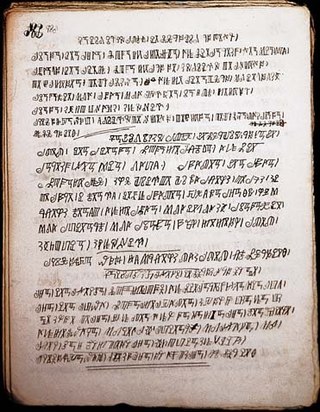Related Research Articles

Devanagari is an Indic script used in the northern Indian subcontinent. Also simply called Nāgari, it is a left-to-right abugida, based on the ancient Brāhmi script. It is one of the official scripts of the Republic of India and Nepal. It was developed and in regular use by the 7th century CE and achieved its modern form by 1000 CE. The Devanāgari script, composed of 48 primary characters, including 14 vowels and 34 consonants, is the fourth most widely adopted writing system in the world, being used for over 120 languages.

The Kannada script is an abugida of the Brahmic family, used to write Kannada, one of the Dravidian languages of South India especially in the state of Karnataka. It is one of the official scripts of the Indian Republic. Kannada script is also widely used for writing Sanskrit texts in Karnataka. Several minor languages, such as Tulu, Konkani, Kodava, Sanketi and Beary, also use alphabets based on the Kannada script. The Kannada and Telugu scripts share very high mutual intellegibility with each other, and are often considered to be regional variants of single script. Other scripts similar to Kannada script are Sinhala script, and Old Peguan script (used in Burma).

The Brahmic scripts, also known as Indic scripts, are a family of abugida writing systems. They are used throughout the Indian subcontinent, Southeast Asia and parts of East Asia. They are descended from the Brahmi script of ancient India and are used by various languages in several language families in South, East and Southeast Asia: Indo-Aryan, Dravidian, Tibeto-Burman, Mongolic, Austroasiatic, Austronesian, and Tai. They were also the source of the dictionary order (gojūon) of Japanese kana.
The Thai script is the abugida used to write Thai, Southern Thai and many other languages spoken in Thailand. The Thai alphabet itself has 44 consonant symbols and 16 vowel symbols that combine into at least 32 vowel forms and four tone diacritics to create characters mostly representing syllables.
Malayalam script is a Brahmic script used commonly to write Malayalam, which is the principal language of Kerala, India, spoken by 45 million people in the world. It is a Dravidian language spoken in the Indian state of Kerala and the union territories of Lakshadweep and Puducherry by the Malayali people. It is one of the official scripts of the Indian Republic. Malayalam script is also widely used for writing Sanskrit texts in Kerala.

In linguistics, romanization is the conversion of text from a different writing system to the Roman (Latin) script, or a system for doing so. Methods of romanization include transliteration, for representing written text, and transcription, for representing the spoken word, and combinations of both. Transcription methods can be subdivided into phonemic transcription, which records the phonemes or units of semantic meaning in speech, and more strict phonetic transcription, which records speech sounds with precision.
Anusvara, also known as Bindu, is a symbol used in many Indic scripts to mark a type of nasal sound, typically transliterated ⟨ṃ⟩ or ⟨ṁ⟩ in standards like ISO 15919 and IAST. Depending on its location in the word and the language for which it is used, its exact pronunciation can vary. In the context of ancient Sanskrit, anusvara is the name of the particular nasal sound itself, regardless of written representation.
Devanagari is an Indic script used for many Indo-Aryan languages of North India and Nepal, including Hindi, Marathi and Nepali, which was the script used to write Classical Sanskrit. There are several somewhat similar methods of transliteration from Devanagari to the Roman script, including the influential and lossless IAST notation. Romanised Devanagari is also called Romanagari.
Telugu script, an abugida from the Brahmic family of scripts, is used to write the Telugu language, a Dravidian language spoken in the Indian states of Andhra Pradesh and Telangana as well as several other neighbouring states. It is one of the official scripts of the Indian Republic. The Telugu script is also widely used for writing Sanskrit texts and to some extent the Gondi language. It gained prominence during the Eastern Chalukyas also known as Vengi Chalukya era. It shares extensive similarities with the Kannada script, as both of them evolved from the Bhattiprolu and Kadamba scripts of the Brahmi family. In 2008, the Telugu language was given the status of a Classical Language of India, in recognition of its rich history and heritage.
The International Alphabet of Sanskrit Transliteration (IAST) is a transliteration scheme that allows the lossless romanisation of Indic scripts as employed by Sanskrit and related Indic languages. It is based on a scheme that emerged during the 19th century from suggestions by Charles Trevelyan, William Jones, Monier Monier-Williams and other scholars, and formalised by the Transliteration Committee of the Geneva Oriental Congress, in September 1894. IAST makes it possible for the reader to read the Indic text unambiguously, exactly as if it were in the original Indic script. It is this faithfulness to the original scripts that accounts for its continuing popularity amongst scholars.
The Royal Thai General System of Transcription (RTGS) is the official system for rendering Thai words in the Latin alphabet. It was published by the Royal Institute of Thailand in early 1917, when Thailand was called Siam.

The Assamese alphabet is a writing system of the Assamese language and is a part of the Bengali-Assamese script. This script was also used in Assam and nearby regions for Sanskrit as well as other languages such as Bodo, Khasi, Mising, Jaintia etc. It evolved from Kamarupi script. The current form of the script has seen continuous development from the 5th-century Umachal/Nagajari-Khanikargaon rock inscriptions written in an eastern variety of the Gupta script, adopting significant traits from the Siddhaṃ script in the 7th century. By the 17th century three styles of Assamese alphabets could be identified that converged to the standard script following typesetting required for printing. The present standard is identical to the Bengali alphabet except for two letters, ৰ (ro) and ৱ (vo); and the letter ক্ষ (khya) has evolved into an individual consonant by itself with its own phonetic quality whereas in the Bengali alphabet it is a conjunct of two letters.
The "Indian languages TRANSliteration" (ITRANS) is an ASCII transliteration scheme for Indic scripts, particularly for the Devanagari script.
There are many systems for the romanization of the Thai language, i.e. representing the language in Latin script. These include systems of transliteration, and transcription. The most seen system in public space is Royal Thai General System of Transcription (RTGS)—the official scheme promulgated by the Royal Thai Institute. It is based on spoken Thai, but disregards tone, vowel length and a few minor sound distinctions.
There are several romanisation schemes for the Malayalam script, including ITRANS and ISO 15919.
Romanisation of Bengali is the representation of written Bengali language in the Latin script. Various romanisation systems for Bengali are used, most of which do not perfectly represent Bengali pronunciation. While different standards for romanisation have been proposed for Bengali, none has been adopted with the same degree of uniformity as Japanese or Sanskrit.
ISO 11940 is an ISO standard for the transliteration of Thai characters, published in 1998 and updated in September 2003 and confirmed in 2008. An extension to this standard named ISO 11940-2 defines a simplified transcription based on it.

The Bamum scripts are an evolutionary series of six scripts created for the Bamum language by Ibrahim Njoya, King of Bamum. They are notable for evolving from a pictographic system to a semi-syllabary in the space of fourteen years, from 1896 to 1910. Bamum type was cast in 1918, but the script fell into disuse around 1931. A project began around 2007 to revive the Bamum script.
ISO 11940-2 is an ISO standard for a simplified transcription of the Thai language into Latin characters.
The Velthuis system of transliteration is an ASCII transliteration scheme for the Sanskrit language from and to the Devanagari script. It was developed in about 1983 by Frans Velthuis, a scholar living in Groningen, Netherlands, who created a popular, high-quality software package in LaTeX for typesetting Devanāgarī. The primary documentation for the scheme is the system's clearly-written software manual. It is based on using the ISO 646 repertoire to represent mnemonically the accents used in standard scholarly transliteration. It does not use diacritics as IAST does. It may optionally use capital letters in a manner similar but not identical to the Harvard-Kyoto or ITRANS schemes.manual para 4.1
References
- ↑ Technical reference manual for the national standardization of ... 2007- Page 39 " ... Nations recommended system was approved in 1972 (I1/ 11) and amended in 1977 (IH/12), based on a report prepared by D. N. Sharma. ... There is no evidence of the use of the system either in India or in international cartographic products. Telugu uses an alphasyllabic script whereby each character represents a syllable rather than one sound. Vowels and diphthongs are marked in two ways: as independent characters (used syllable-initially) and in an abbreviated form, ......
- ↑ "Telugu chart" (PDF). www.unicode.org. Retrieved 10 November 2020.
- ↑ Information Systems for Indian Languages: International ... - Page 131 Chandan Singh, Gurpreet Singh Lehal, Jyotsna Sengupta - 2011 "Table 1. The Indian Language Transliteration (ITRANS) symbols of phonemes common to three languages Hindi, Tamil and Telugu Manual labeling of the recorded data has been carried out."
- ↑ English-Telugu Dictionary - Page li ISBN 8120616367 Vemuri Rao - 2002 "Transliteration of Telugu using RTS This dictionary uses RTS (Rice University's Reverse Transliteration System) for the transliteration of Telugu using Roman script.
- ↑ "Read / Write Telugu in Linux". e-తెలుగు. 1 July 2010. Retrieved 10 April 2014.